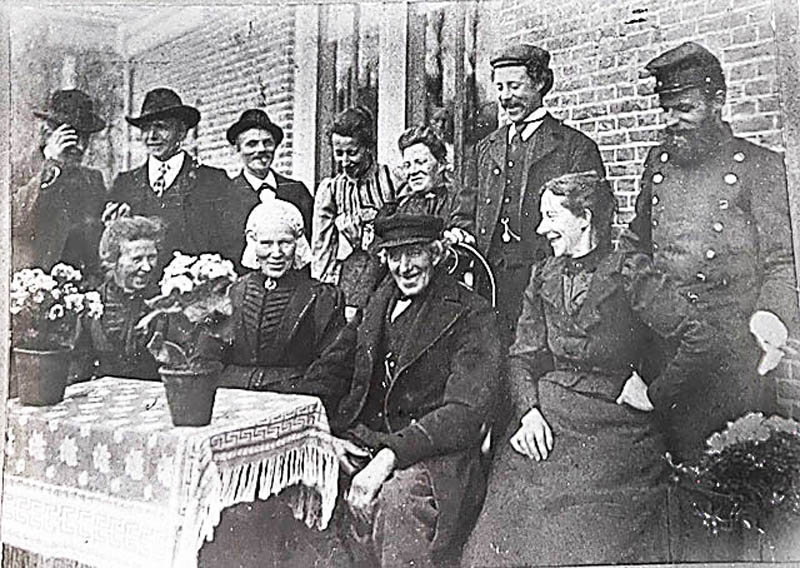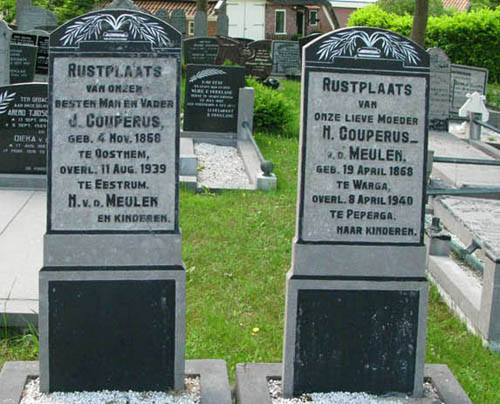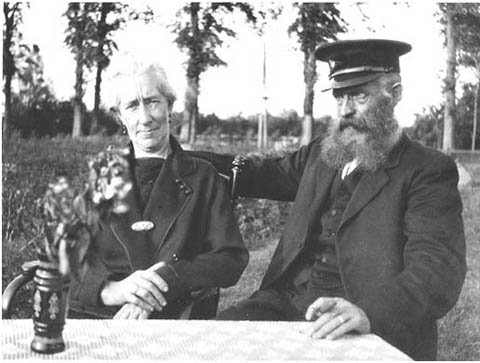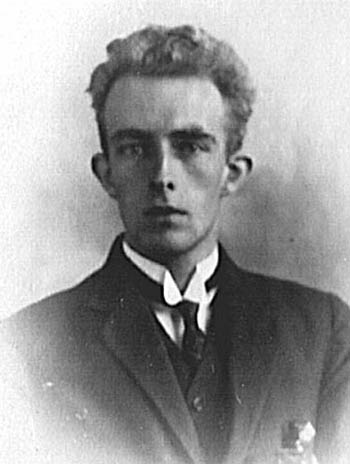
The oldest photos we have of any of my ancestors are of my Great-Grandfather and his wife.

Sitting at the table is Epeus Couperus (1835-1917) after whom my Father was named, and his wife Hinke (1842-1920).
We don't know what he did for a living. Neither do we know when this photo was taken, although a good guess would be around the turn of the century 1900 - for example the young couple on the far right of the picture (my Grandparents) had their first child in 1894.
We also have what we think is a portrait of my Great-Grandmother, that might have been taken at the same occasion
|
|
Standing at the far right of the first picture above and looking down at the couple are a man wearing a military-style cap and button-up tunic. That is my Grandfather and in front of him with her hand on her hip, is his wife Hylkje.
I was named after my Grandfather, Jitze Couperus. He was born in 1868 and died in August 1939, just days before the outbreak of World War II in Europe on 1st of September.
 |
His wife Hylkje van der Meulen was born in the same year that he was, and died just a few months after hed did.
He was a "Veldwachter" in a small village in Friesland called Eestrum (or "Jistrum" in Frisian), his job being more-or-less equivalent to that of a village policeman.
Out of this marriage came six children:
He was a very stern looking man, but I understand that my Grandmother Hylkje was the taller of the two from which my Dad and I inherited our above-average length.
 |
 |
Each of the children married and had children of their own except for Hinke, the eldest.

His formal name was Epeus (with a middle name of Gerardus) but in daily life he was known as Pé or Peter. He was born in Oenkerk, another small village close to Eestrum (but with roughly double the population at 1800) and in the same general municipal district of Tietjerksteradeel.
He never talked much about his early life, but from what I can gather, he attended local schools until he had attained the age where school attendance was no longer mandatory. By custom, it was usualy the oldest son in the family who inherited any property and who was favored with further education if the family could afford it. Thus his older brother Wiebe received some amount of post-school training (initially he connected and installed electric power to houses and farms in Friesland as electricity became generaly available - later he was chief maintenance engineer for a slaughter house/meat factory in Wageningen). But my father was sent on his way to find gainfull employment wherever he could.
A short article was published about his career in the local village newsletter in 1988 which says "...Na zijn lagere schooljaren op de openbare school, leerde hij schriftelijk Engels en was even kantoorbediende bij de betonfirma Haitsma te Schuilenburg..."
Roughly translated this tells us that after his schooling at the public elementary school, he learned written English and worked for a little while in the office at the concrete company Haitsma at Schuilenburg. However the author of this article has not been identified and we don't know where he (or she?) got this information from. The rest of the article is so wildly inaccurate that this little piece of information must also be viewed with with scepticism.
The article goes on to say "...Hij heeft vermoedelijk in London een correspondentievriend gehad. Want op ongeveer 22 jarige leeftijd reisde Pé (Epeus), zoals de Eestrumer hem kende, naar London om zich daar in de Engelse taal te bekwamen..."
Roughly translated: "...Apparently he had a pen friend in London because at roughly 22 years of age Pé (Epeus) as he was known in Eestrum, travelled to London to achieve mastery of the English Language...". This added information is equally questionable, but either way it it leaves a gap of many years from when he left school (around 14 or 15 years of age) until he was 22. Some eight years have passed before he "goes to London" and thereby hangs a tale. My Dad was very reticent about this period of his life, but occasionaly he or my mother would offer anecdotes which I have pieced together as best I can as follows.
 |
Apparently one rainy day he had a large delivery of eggs to be made at a place called "Clingendael". Today this is a well-known public attraction whose history
is summarised briefly below from information I found on the web.
|
I underlined the name of "Lady Daisy" in the passage above because unwittingly she was to be the one who would most radically affect the future path taken by my father, and of course all that followed in the family history.
It was a rainy day in the autumn when he rode his bike, carrying a large delivery of eggs up the main drive to the tradesman's entrance behind the mansion. The cobbled roadway was covered in wet leaves and the bicycle slipped out from under him - he landed on his elbow on the hard surface hurting it considerably. Not only that, but a large number of eggs came out of the basket and also landed hard on the cobbles with the expected consequences.
As he lay there crying from the pain and the loss of the eggs (which he feared might cost him his job) the kitchen servants came out and helped him inside to clean him up and make sure he was alright. Apparently a lady of the house became aware of the commotion and appeared in the kitchen to see what all the fuss was about and why the young lad was crying. The situation was explained to her.This was the Baroness van Brienen (Lady Daisy) that I mentioned previously.
She asked my Dad to stand next to another of her servants to check his height (my Dad was about 6ft 3 inches, or 190 cm.) It turns out that the Baroness was looking for a second "footman" who was similar in stature to the one she already had in her employ - but it was important that they be matched in height because on special occasions the Baroness would ride in her coach with two footmen standing on the back in uniform, and they needed to be a matched pair. (I translated the Dutch words my Dad used, "livreiknecht" and "lakei" into "footman" which I think would be the closest equivalent.)
 |
He was there for a few years until the Baroness recommended him for a promotion and to work for one of her friends, the Lady Amelia Cavendish-Bentinck. There was a mutual interest connection between these two ladies which plays a role in this context. Lady Amelia Cavendish-Bentinck had a significant interest or connections with the "British Tin Smelting Company" and Lady Daisy had a similar involvement with the Dutch mining company "Billiton" (about which more below) whose primary focus at that time was tin mining, in the Far East and South America.
The Cavendish-Bentinck clan was an aristocratic family with legs both in England and in Holland. They owned (still own) large pieces of London - mainly around Mayfair, the most expensive part of town - and the Bentinck side of the family had an estate ("landgoed") somewhere in the eastern part of the country known as the "Achterhoek" (near Lochem somewhere I believe) as well as a "pied-a-terre" in The Hague either on or very near to Plein 1813. I can remember my father pointing out the building when I was working in The Hague many years later.
So now he had moved up in the world with a new job which was more of an assistant butler. And as such he travelled with the family. They spent 6 months of every year in The Hague and the rest of the year in London - which is how he got to improve his English and at the same time he took night-classes in book-keeping because he had to look after the accounts for the kitchen household. He also took some informal tutoring classes in "Business English" and paid for them by selling the same class to a colleague later in the day for a small profit.
At some point when they were in London, Lady Cavendish-Bentinck attended a lecture (or read a book?) about King Solomon’s Mines which was a popular topic at the time. She was persuaded by someone that the mines probably existed in the "Mountains of the Moon" (currently known as Ruwenzori Mountains) located in central Africa on the border between Uganda and The Congo. She got excited by this and decided to fund an exploratory expedition of 3 people to go search for these mines. She had connections with a Dutch company called "Billiton" (which still exists today, but is now a big multinational after merging with the Australian BHP mining company) and recruited a geologist from there, and two other young men from her staff - one of which was my Dad. Their mission was to go look for the mines.